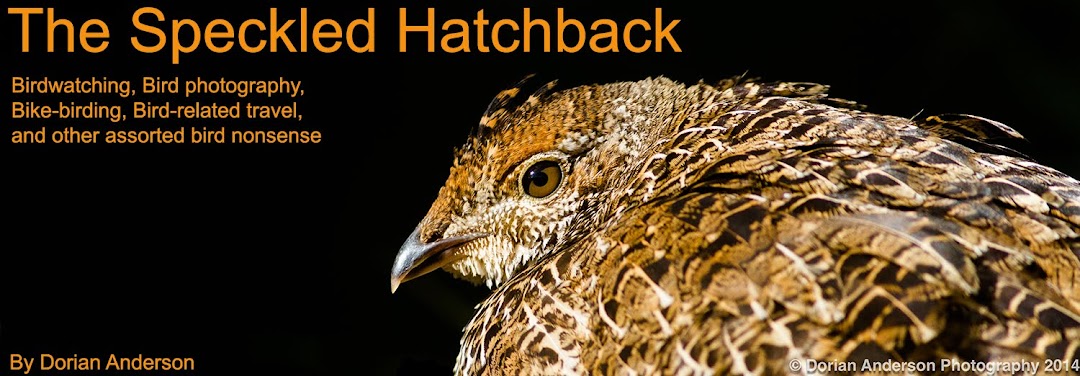Woo Hoo! First post of 2016, yet another Big Year for me! Just joking, I'm still recovering from the last one! Let's get year 2 kicked off in style. Please do share this blog with anyone and everyone you think might find all this bird-craziness at all interesting or entertaining. The more the merrier, right? I am going to try to update it each Tuesday, but some of that will be dependent on my ability to get out birding/photographing to generate content. Easier said than done working a a 60/hr a week job and writing a book on the side!
A few weeks ago, in South Texas, I photographed this presumed Gadwall-Pintail hybrid. Last week I stumbled across a Pintail-Mallard hybrid here in Southern California. Sadly, I did not have my camera with me so you'll have to use your imagination for that one...
Presumed Northern Pintail x Gadwall hybrid
Anyway, the Mallard-Pintail from last week really got me thinking. I realized that I have photographed a few other hybrids in the last few years. I'll share these photos with you and we can together try to sort out who came from who. Sound good? Let's start with this odd oriole. This bird was photographed in Arizona (Portal) in May of 2014 during my bicycle Big Year.
Hybrid oriole
The first thing that jumps out about this bird is the facial pattern. Bullock's Oriole would have a generally orange face with a black eyeline. This bird has more black than would be expected on the face of that western species, but not a full black hood like that of the more eastern Baltimore Oriole. The facial pattern thus seems intermediate between the two species. So does the wing pattern, with the coverts showing more white than a Baltimore but not the extent of the Bullock's. So far as I can discern, this is a Bullock's x Baltimore hybrid. I am sure that there are some other, subtler nuances that better birders might be able to glean from the photo, but I feel that between these two, generally easy-to-see-and-discuss field marks, there won't be too many fights about this identification.
Next up is an interesting shorebird that I photographed on Plum Island in September of 2013. The images are heavily cropped and the lighting was beyond terrible, but we can start to deconstruct the genetics that possibly produced this rarest of rare birds.
Hybrid sandpiper
I nearly wet myself when I first laid eyes on this bird. It was initially spotted by Massachusetts birder Suzanne Sullivan as it flew in to join a group of several hundred similarly sized shorebirds. She immediately pointed it out to me, and we both realized that we were looking at something incredibly rare. Mentally running through the possibilities, we quickly realized it was a hybrid of some sort. I was able, with much maneuvering in the mud, to obtain at least one other decent shot of it. The bird on the left is a White-rumped Sandpiper (WRSA) and will provide a starting point for our dissection.
White-rumped Sandpiper (L) and presumed hybrid sandpiper (R)
Our mystery bird is about the size of the WRSA. It has remarkably generally similar shape and wings that reach the tip of the tail. Though it is not easy to see in this photo, the first photo shows the bill to be both longer and more decurved than a pure-bred WRSA. Its bill shape is actually more suggestive of a Dunlin than anything else. The streaked flanks and breast are also suggestive of WRSA, but rufous color on the back and head are all wrong for that species. Here again, the bird resembles, a Dunlin. Dunlin do not normally have rufous heads, but the head pattern at least resembles WRSA. So, without being able to obtain a feather for DNA analysis to confirm my speculation, the phenotype suggests that our mystery bird might in fact be a White-rumped Sandpiper - Dunlin, a "Rumplin" as some have dubbed the intergrade. Whatever it was it was certainly very exciting when in appeared!
Last is this presumed hybrid warbler several of us found and photographed in Ventura, California in October of 2013. It was in a huge feeding flock comprised mainly of Yellow-rumped Warblers and Townsend's Warblers.
Hybrid warbler

Without a good look at the face, this bird could easily be passed off as yet another Yellow-rumped Warbler among the hoards with which it was associating; It has a generally gray-brown back, faint streaks on a dusky breast, and a yellow rump, all general features of winter plumage Yellow-rumps. However, with a good face view, pure-bred Yellow-rumped Warbler seems highly unlikely. The main thing that jumps out is the broad supercillium above the eye. This feature, to me, is strongly suggestive of 2 eastern species, Blackburnian Warbler and Cerulean Warbler. This bird does have 2 white wing bars which is consistent with both of those species, but the generally gray color isn't right for either. The back is unstreaked, a feature of Cerulean. The problem is that that feature could have come from the other parent, so it doesn't allow us to firmly conclude much. So, while I am far from certain about anything on this bird, it seems that it could be a Yellow-rump x Cerulean or a Yellow-rump x Blackburnian hybrid warbler. I guess it is also possible that one parent of this bird was a hybrid that mated with a pure bred species. Who knows?!?!? I welcome any input anyone has on any of these birds.
I personally find hybrids to be loads of fun. There are obviously incredibly rare, and they usually stimulate at least some identification debates in the birdosphere. I like to keep the discussions fairly general; I'm not into dissecting every single individual feather. I mean, were never going to know for sure, right? If I find any more in the future, you can bet they will appear here!













